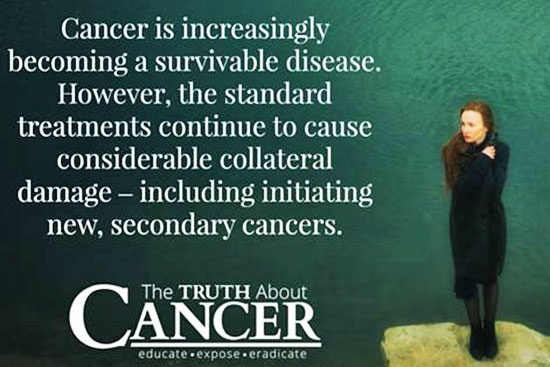|
from
DrSircus Website
No, you will not drop dead as fast as rifles loaded with lead but on a cellular level the death and devastation can be as great. Radiotherapy can leave patients with a lifetime of suffering with life expectancy severely shortened.
The New York Times said,
Thousands of cancer survivors have developed terrible conditions as a result of the radiotherapy treatment that helped save them.
Radiation treatments do, in the short run, save people and children’s lives yet often at a terrible cost in the future. What is unforgiveable is that they do not try safer things first.
One of the worst consequences of radiation therapy is the development of a secondary cancer because increased radiation exposure leads to more incidences of cancer.
The cancer epidemic is getting worse but it is a survivable disease; yet the treatments cause considerable collateral damage - including initiating new, second cancers, terrible burns, and a long list of other problems depending on the target area of treatment.
That is exactly what oncologists do; they use radiation that causes cancer to diagnosis and treat it. Not exactly the most intelligent treatment approach. Then when you consider that in radiation therapy, they are administering lethal or near lethal dosages (see below) we begin to understand the cruelty of oncologists and how the analogy of voluntarily stepping in front of a firing squad is real...
Most patients feel backed up against the wall by their oncologists whose licenses would be ripped away if they dare to suggest safer, less expensive alternative treatments first.
Doctors themselves sometimes refer to the risk of a second cancer as "friendly fire" - that is treatment for one cancer resulting in the initiation of a second cancer. Oncologists routinely fail to mention to their patients the possibility that second cancers can be created by the very cancer treatment they are administering.
The American Cancer Society acknowledges that chemotherapy and radiotherapy are carcinogens and may increase risk for developing a second cancer, and that the risk is even higher when both therapies are given together.
Secondary cancers are lethal so they are admitting that you are in front of a nuclear firing squad when taking radiation, just might take a few years before you drop to the ground.
Slow motion death. Death by radiation exposure...
Dr. Walter Russel was right, nuclear radiation is the death principle. He wrote Atomic Suicide before most of us where born and it is suicidal to expose yourself to diagnostic and treatment procedures that pump in the death activating radiation.
It is not the only way to treat cancer successfully.
Every physician knows that radiation can lead to cancer but their recklessness is so great that they continue to expose their patients even after the Fukushima accident, which should be telling doctors to slam on the breaks at radiation departments.
The last thing patients need after being exposed to radiation from Fukushima is exposure to more radiation.
Dr. Edward Golembe, who directs a hyperbaric oxygen chamber at Brookdale University Hospital in Brooklyn, said he had treated serious radiation injuries to the jaw and called them,
When we deal with radiation we deal with death for it is the death principle that doctors are trying to harness with terrible results.
Most people who employ radiation in their treatments for cancer suffer horribly though it might save their life in the short term.
Radiation therapy has been linked to the occurrence of solid tumors of the lung, stomach, and bone, and to various types of leukemia such as,
Radiation hazards have been grossly underestimated because they have to be.
If they were not then both the medical industry and the atomic power industry would be vulnerable to staggering liabilities.
Nuclear Bullets
When just one of these nuclear particles or rays goes crashing through some material, it collides violently with atoms or molecules along the way...
In the delicately balanced economy of the cell, this sudden disruption can be disastrous. The individual cell may die; it may recover. However, if it does recover, after the passage of weeks, months or years, it may begin to proliferate wildly in the uncontrolled growth.
Radiation consists of several types of subatomic particles, principally those called gamma rays, neutrons, electrons, and alpha particles, that shoot through space at very high speeds, something like 100,000 miles per second.
They can easily penetrate deep inside the human body, damaging some of the biological cells of which the body is composed.
This damage can cause a fatal cancer to develop, or if it occurs in reproductive cells, it can cause genetic defects in later generations of offspring.
Radiation takes place when the atomic nucleus of an unstable atom decays and starts releasing ionizing particles, known as ionizing radiation.
When these particles come into contact with organic material, such as human tissue, they will damage them if levels are high enough, causing burns and cancer.
The American Cancer Society concedes,
Can Kill or Destroy Your Life
An undiscussed danger of radiation therapy to the head is increased risk of stroke. [1]
A study of head and neck cancer patients who received radiation therapy found that stroke rates were five times greater than expected. [2]
This elevated stroke risk was found many years after administration of radiation. The average time between radiation treatment and stroke was 10.9 years, but the increased risk of stroke persisted for 15 years after radiation therapy.
Late side effects occur months to years after finishing radiation.
They can include:
Radiation can also affect salivary function, thyroid function and gonadal function long term.
Pelvis
Radiation therapy aimed at the pelvis may cause these side effects:
In addition, radiation therapy to the pelvis can cause different symptoms for men and women:
How it Happens
Radiation therapy seems to create cancer stem cells and that means instead of treating cancer they are causing cancer.
The news has published about the undesirable effect of helping to create cancer stem cells - cells that researchers say are particularly adept at generating new tumors and are especially resistant to treatment.
The medical media is saying that this might help explain why late-stage cancers are often resistant to both radiation therapy and chemotherapy.
We know that cancer stem cells give rise to new tumors.
These stem cells are ultimately responsible for the recurrence of cancer or the dangerous spreading of it throughout the body.
Scientists also have found that cancer stem cells are more likely than other cancer cells to survive chemotherapies and radiation therapies, probably because their "stemness" allows them to self-replenish by repairing their damaged DNA and removing toxins.
An amazing statement considering these doctors have all along been playing around with super-toxic chemotherapy poisons and radioactive death-inducing rays - and now, they are surprised that this is the mechanism of death?
Low and High Exposures
If children are exposed to X-rays while still in the mother’s womb (in utero), their risk of all cancers increases by 40 percent, of tumors of the nervous system by 50 percent, and of leukemia by 70 percent.
Today there are thousands of people with damaged thyroid glands, many of them with cancer, who were radiated with X-rays on the head, neck, shoulder or upper chest 20-30 years ago. Ten X-ray exposures at the dentist’s office are sufficient to produce cancer of the thyroid.
Multiple X-rays have been linked with multiple myeloma - a form of bone marrow cancer.
When radiation therapy is used to treat cancer, a very large dose of radiation, about 5,000,000 millirem (or 5,000 rem) (50,000 mSv) is delivered to the tumor site.
Below is a chart that says that each dose of radiation treatment delivers 2,000,000 millirem so with the multiple treatments most patients receive it is easy to see how fast they get up to a fatal dose.
Ten thousand mSv is a fatal dose. That is 10,000,000 millirem...
Click above image
Perhaps the best way to understand this is to compare it with natural radiation - the 15,000 particles from natural sources that strike us each second throughout life.
One millirem of exposure corresponds to being struck by approximately 7 billion particles of radiation.
Do the math if you have a calculator that goes up that high. That is five to ten million mrem multiplied by 7 billion particles slamming into patients during their radiation treatments.
We are constantly bombarded from above by cosmic rays showering down on us from outer space, hitting us with 30 mrem per year.
Combined with other natural source we are all exposed a total average dose of about 85 mrem per year from natural sources, or 1 mrem every 4 days...
References
|




